IAS, IPS, IFS: Meet 12 Officers Who Excelled in Public Service in 2021
IAS, IPS, IFS: Meet the 12 officers whose exemplary work in 2021 ensured that we picked them for our 'Excellence in Public Service' yearender list.
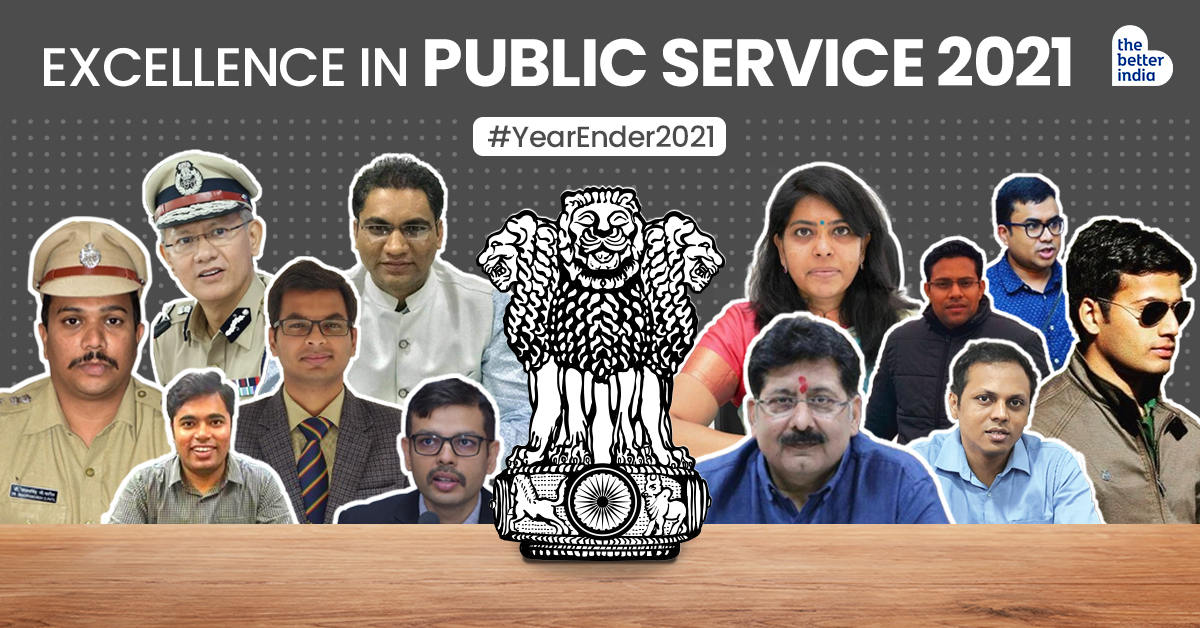
While we are quick to criticise and find fault with bureaucrats, we often fail to praise the good work done by them. The last two years have been exceptionally tough with COVID-19 cases surging all through the country. But the initiatives launched by a few officers helped districts tide over the tough time seamlessly.
Whether it was to ensure that medical aid, oxygen supply and hospital beds were available or in reviving water bodies and generating employment during COVID-19, here’s a list of 12 officers across various districts whose work is truly praiseworthy.
1. Dr Rajendra Bharud, IAS
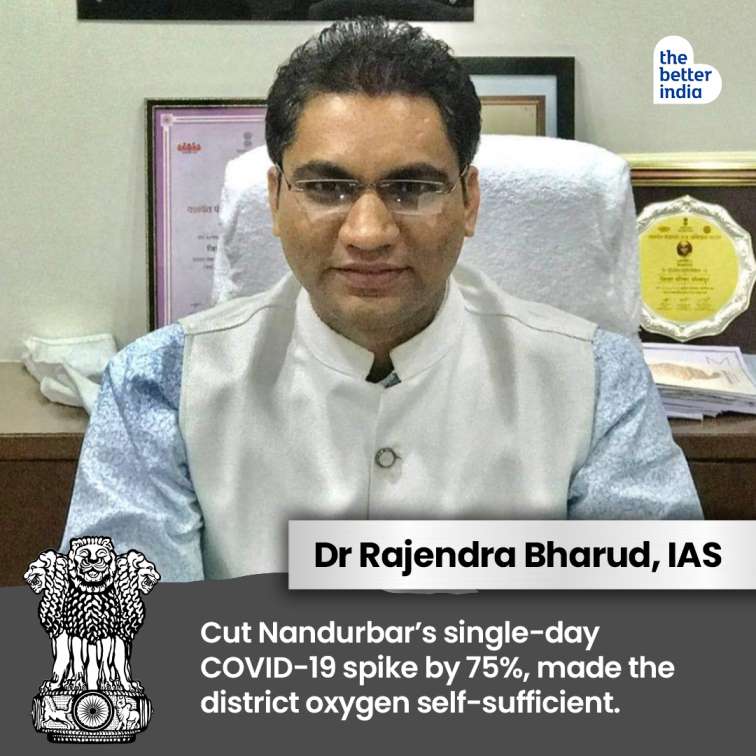
Dr Rajendra Bharud holds the distinction of cutting Nandurbar’s single-day COVID-19 spike by 75 per cent and also making the district self-sufficient in its oxygen requirement. During the second wave of COVID-19, when there was an acute shortage of hospital beds, medicines and even oxygen supply, Dr Rajendra managed the impossible.
Even with a population of over 16 lakh people in Maharastra’s Nandurbar district, it had 150 vacant beds and two oxygen plants that have a combined capacity to produce 2,400 litres per minute.
In an interview with The Better India, Dr Rajendra said, “We didn’t want our doctors to be under any kind of pressure, and provided them with everything they needed, even if that meant spending Rs 85,00,000 per oxygen plant. Oxygen cylinders are manufactured only in certain states, so by the time they arrive, several lives are at risk. Our plants directly extract air and provide oxygen through pipes to the patients. We also made sure that oxygen pipes were given as soon as saturation levels started dropping, instead of waiting for the critical stage. This way, patients use only 30 per cent of oxygen, as against 90 per cent in the latter situation. When oxygen starts dropping, it directly affects the brain and kidneys, which makes it harder for patients to recover fast. Hence, oxygen levels need to be managed and taken care of in the early stages itself.”
2. Rajendra Bhatt, IAS

Widely known for the Bhilwara Model, which is a multi-level plan that successfully curbed the community spread of COVID-19 in the hotspot district, it was IAS Officer Rajendra Bhatt who conceptualised and executed this. With the first COVID-19 case reported on 19 March 2020 in the district, no time was lost in figuring out a plan to curb the spread, Rajendra Bhatt and his team were ready with a plan of action which they swiftly implemented.
Creating medical emergency centres in various hotels and resorts in the district, imposing very strict curfew rules, setting up teams to monitor patients under home isolation, door to door supply of milk, groceries and screening, and tying up with Akshaya Patra to provide nutritious food to those in isolation were just a few steps that this district administration put in place.
Rajendra Bhatt in an interview to The Week said, “It is encouraging to learn that the Bhilwara model is being looked at by other states as a format that can be emulated. However, I would like to stress that what we did was specific to the scenario in Bhilwara, where a hospital had become an epicentre of infection, and the measures took into account the demographics. It is not a one-size-fits-all strategy. The Bhilwara model can be emulated in a district with an urban population of around five to 10 lakh, and a rural population of 25 to 35 lakh. But you cannot implement it in big cities like Delhi and Mumbai, where the population density is high.”
3. Dr T Arun, IAS
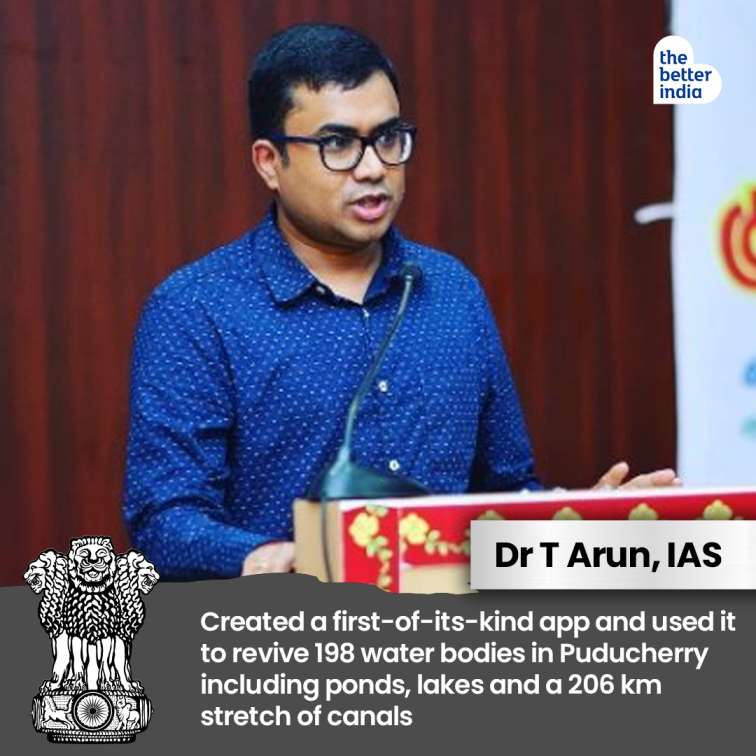
While the online ecosystem is flooded with apps, this one created by Dr T Arun, Puducherry District Collector, is a first-of-its-kind app, which has been used to revive 198 water bodies in Puducherry including ponds, lakes and a 206 km stretch of canals. Called ‘Neer Padhivu’, the app helps digitalise water bodies with geotagging, unique ID numbers, GIS on ponds, tanks with latitudes and longitudes coordinates. Each water body is updated with the status of groundwater levels, moisture content of soil and size via remote sensing satellites.
Speaking to The Better India, Dr Arun said, “The application, developed by the CSIR (Council of Scientific and Industrial Research) – National Environmental Engineering Research Institute, has not only helped streamline the rejuvenation process but is also ensuring that people don’t dirty or encroach the water bodies. The digital world can surprise you in many ways, and we are glad to bring a modern solution to the district’s severe water crisis.” To ensure the success of this initiative, Dr Arun also roped in the community members and made them equal stakeholders in ensuring its success.
Corporates, NGOs, schools and local community members came together to see this initiative through. “If people participate in the cleaning process, they learn about the benefits of water bodies and will be mindful of dirtying them in the future. Some communities have pledged to monitor water bodies for life. Another reason was to save the Government Exchequer — the entire project is funded through CSR activities. Participation by schools was a surprise element. They learnt about our project through our awareness programmes and wanted to involve their students,” said Dr Arun.
4. T Bhoobalan, IAS

At a time when the country was reeling under COVID-19 and its rapid spread, T Bhoobalan, Zilla Parishad CEO of Bagalkot district in Karnataka had the issue of child marriage to tackle. Between April and July 2020 alone, Karnataka reported 107 cases of child marriage. Bhoobalan adopted a multi-pronged approach to tackle the sharp rise in child marriages in Bagalkot amid the pandemic and rescued 176 kids from being married off underage in one year.
Working on understanding the severity of the issue, Bhoobalan created a task force comprising government officials and school teachers. Speaking to The Better India, he said, “While talking to the locals, we realised that the lockdown has also affected them psychologically. Elders in the family believe they will die from coronavirus and won’t get to see the wedding. So, many underage children are obligated to fulfil their family’s last wishes. Our team mitigated the panic. Another issue was the youth having to migrate back to the villages due to lack of work. They were being forced to marry. So, we gave them jobs through MGNREGA.’”
These steps helped in bringing down the number of complaints and also resulted in stopping close to 176 child marriages. Ten girls whose marriages had already taken place were directed to go back home and return to their in-laws’ home only after they turned 18. Ensuring the well-being of the child, after the marriage is stopped the Child Welfare Committee members counsel the child and depending on the child’s mental health and financial situation, they are sent back home or kept under the custody of a child welfare home.
5. S Seeram Sambasiva Rao, IAS
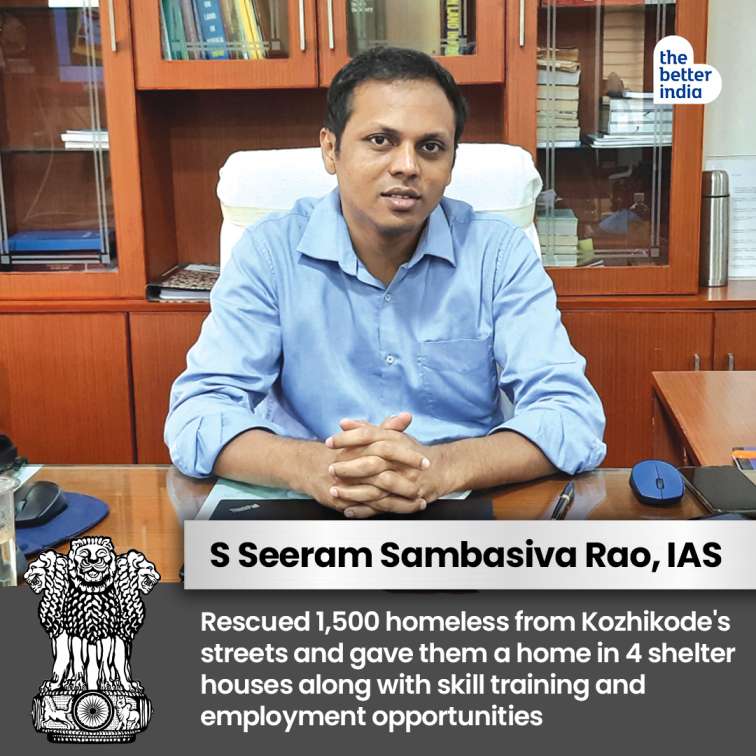
District Collector S Seeram Sambasiva Rao set up the Udayam Charitable Society to establish and run four shelter homes in East Hill, Mankavu, Vellimadukunnu and Chevayur. Having been posted to the district two years ago, one of his goals was to provide shelter homes to the street dwellers under the state’s ‘Nammude Kozhikode’ project for development. Through this initiative, close to 1,500 homeless were taken off the streets and transferred to various shelter homes in the last 18 months. Additionally, the district administration also took the responsibility of reuniting the homeless with their families, giving them skill training and employment opportunities.
Speaking to The Better India, Seeram said, “Way before COVID-19 hit India, we conducted multiple visits at railway stations, bus stands, public parks and more to analyse the situation of the homeless. The majority of them were migrant workers from North India who were working as wage labourers and domestic help. We told them about giving them a shelter home but they refused. It was hard for them to believe that the government was going to take efforts for them. After that attempt failed, during the lockdown we got another opportunity, and this time the situation was different.”
While this initiative was launched pre-COVID, the pandemic only pushed those in charge of this project to work harder. Since many of the homeless had co-morbidities and were susceptible to contracting the virus, finding them proper shelter became imperative. Close to 1,000 inmates were provided meals and were groomed for their well-being through haircuts, surgeries, counselling, medical check-ups, etc. The ones who did not have ID cards were given new ones and a literacy programme, ‘Jnanodayam’ and certification exams were also conducted to help them earn a steady income.
6. Shalini Agarwal, IAS
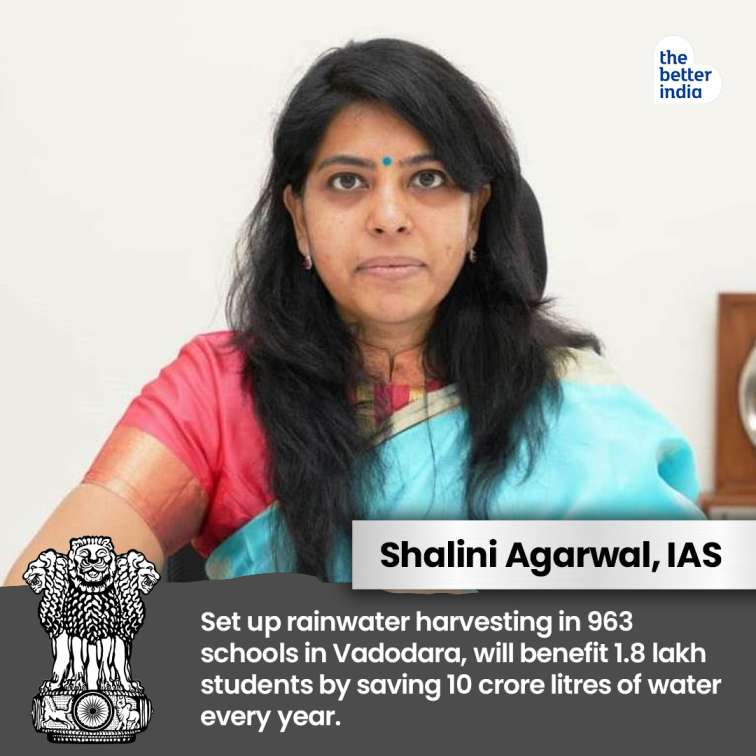
To tackle the issue of acute water shortage in Vadodara, Shalini Agarwal, District Collector came up with an ingenious solution of setting up rainwater harvesting in 963 schools in the state, which in turn helped 1.8 lakh students by saving 10 crore litres of water every year. Varsha Kal Nidhi was launched by Shalini in 2020 and through this initiative, rainwater is collected from the terrace and channelised through pipes towards a chamber in the ground. The chamber then filters and percolates the water in the bore wells, ensuring direct groundwater recharge.
Speaking to The Better India, Shalini emphasised the need to involve communities in making this work and says that children became the biggest ambassadors of the initiative. She said, “Various workshops, competitions and events were held across Vadodara where children became our brand ambassadors and people were sensitised about the importance of conservation. Such initiatives help us realise the importance of water and motivate others. Everyone consumes water and it is a valuable resource passed on by generations. We must conserve and make it available for future generations.”
7. Dr Adarsh Singh, IAS
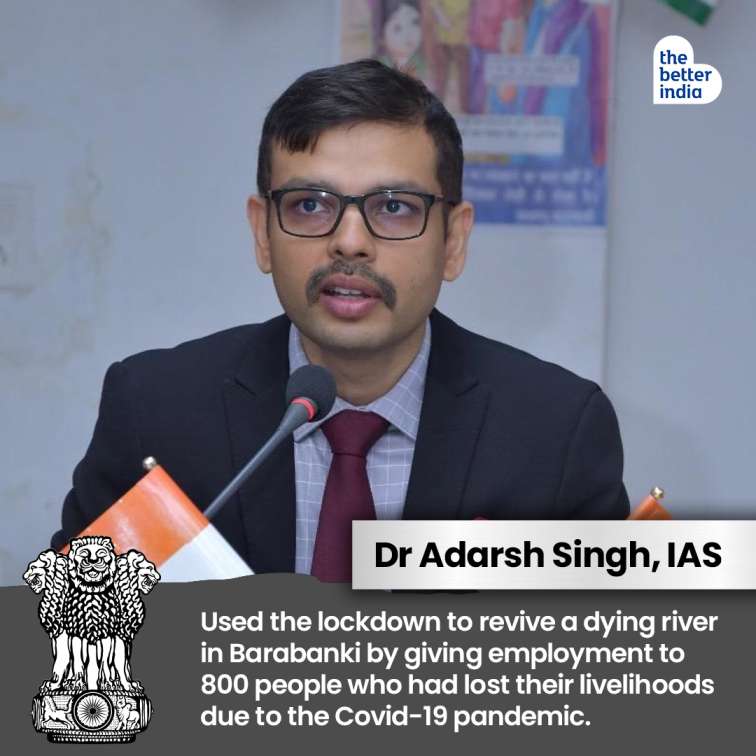
Dr Adarsh Singh, District Magistrate, Barabanki, used the lockdown to revive a dying river in the district by giving employment to 800 people who had lost their livelihoods due to the COVID-19 pandemic. At a time when people were losing their jobs and getting impacted by severe pay cuts, Dr Adarsh used the time to generate employment and also tackle an environmental crisis.
In an interview with The Better India, Dr Adarsh said, “Lockdown was, in a way, a boon in disguise for us. We had to stop in February due to movement restrictions. When we learnt about the plight of daily wage earners and how their livelihoods were in danger, we thought of employing them to solve the two problems.” IAS officer, Deputy Commissioner, MNREGA-Barabanki, N D Dwivedi and Block Development officer Hemanth Kumar Yadav were two other officers who provided all the support for this initiative. They adopted measures such as sensitising villagers, eliminating encroachments, reducing garbage dumping, and open defecation on the river bank.
The district authorities also sensitised people about open defecation and dumping garbage in the river, “It wasn’t difficult to get people’s cooperation after we told them they could use the river water for farming,” added Dr Adarsh.
8. Anupam Sharma, IFS

An annual tree-planting drive with 4.7 lakh saplings in the Maihar district of Madhya Pradesh left sub-divisional officer Anupam Sharma aghast. Speaking to The Better India, he said, “The forest department had planted about five lakh saplings, and each of them came wrapped with a plastic bag. On one hand, we were working towards the cause of the environment, while on the other, about 5,000 kilos of plastic waste had accumulated because of us, with no legitimate way of managing it.” This was what led to utilising the 5000 kg of plastic waste to generate sustainable employment opportunities for three villages in Maihar.
With the help of Bhavna, a solid waste management expert and also the wife of Anupam Sharma, a biogas plant was set up at an old-age home, installing an oil presser machine and a spice grinder unit. The aim was to help create employment opportunities for the villagers while also managing the plastic waste generated efficiently.
The biogas plant helps serve some needs of the Maa Sharada Devi Temple Management Committee’s Old-Age Home where the biogas plant helps generate enough gas supply to prepare morning and evening tea for the residents and also helps mitigate wet waste generated on the premises. “There are millions of trees planted across the country every year, and the cumulative effect of the untreated plastic from tree plantation drives can have vast detrimental effects on the environment. Such waste management models can make tree plantation drives environment friendly in the true sense,” said Anupam.
9. Dharam Singh Meena, IFS

The disappearance of natural springs in the Uttarakhand and Himalayan sub-continent is a cause for concern. The disappearance of these precious water sources can be attributed to erratic rainfall, mainly due to climate change. The water shortage is also because of the change in land use patterns owing to rampant development. Divisional forest officer Dharam Singh Meena noticed this and decided to rectify the issue.
Dharam Singh and his team managed to revive 66 Himalayan springs in Tehri Garhwal to provide a sustainable water supply that now helps over one lakh people across 23 villages. Speaking to The Better India, he said that all the springs have been GIS mapped to maintain transparency and monitored in real-time. “Preserving and protecting each stream is a challenge and crucial for the coming decades.”
The timely intervention by the authorities has helped not only revive the springs but also generate employment and livelihood opportunities.
10. Vikas Ujjwal, IFS

Vikas Ujjwal is a Divisional Forest Officer from Jharkhand who worked towards transforming a 5,000-hectare forest in just four years by curbing illegal felling of trees and also bringing forest fires under control. In doing this he also helped villagers in Jharkhand’s Lohardhaga convert dry leaves into briquettes, which in turn added to their income.
The concerted effort of this officer and his team has helped restore the rich biodiversity of the forest. This in turn has led to the return of wildlife like sloth bears, fox, hyena, deer and porcupine and natural water streams. Not just this, but new income-generating activities like beekeeping, bamboo craft and ecotourism has also helped in supplementing the income of the local communities. Some villagers have also been employed by the forest department as fire watchers.
Speaking to The Better India, Vikas said, “This forest landscape is crucial for water security of Jharkhand as three important rivers i.e. Damodar, Sankh and Auranga originate from here. With better protection of forests, we have improved the water retention ability of the forest floor. Additionally, due to the better vigilance of Joint Forest Management Committees (JFMC), we have reduced incidents of illicit felling. No major forest fires have occurred in the last four years.”
11. Damodar Gautam Sawang, IPS
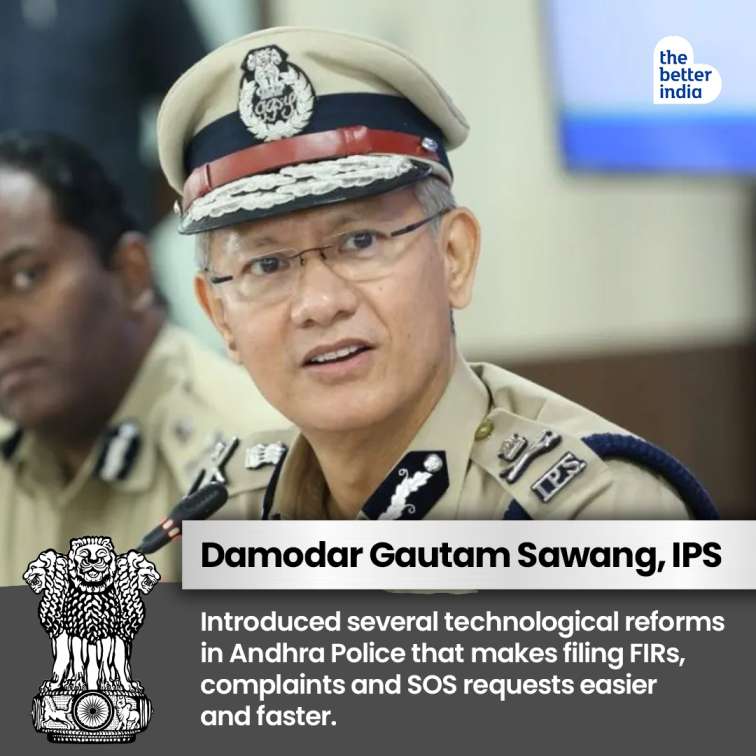
Chosen as India’s best Director General of Police (DGP), Damodar Gautam Sawang has introduced several technological reforms in Andhra Police that makes filing FIRs, complaints and SOS requests easier and faster.
Emphasising the need to merge technology and governance, in an interview with The Better India, Damodar said, “Technology is a tool to bring about change. Even before the COVID-19 pandemic led to our world becoming virtual, people were hooked to their mobile phones and other gadgets. Several people prefer to do everyday tasks with the click of a button, and I thought this could hold true for legal services too.”
The technological changes that were introduced helped in bringing about transparency and also accountability amongst the departments. A new file management system that was introduced by the officer helped in speedy investigations and also to the completion of 85 per cent of cases.
A mobile application called AP Police Seva was launched and within five months, 2,64,000 FIR downloads were seen. Additionally, the Disha Mobile app for women was also launched which saw 12.57 lakh downloads within five months.
12. Dr Sangram Singh Patil, IPS
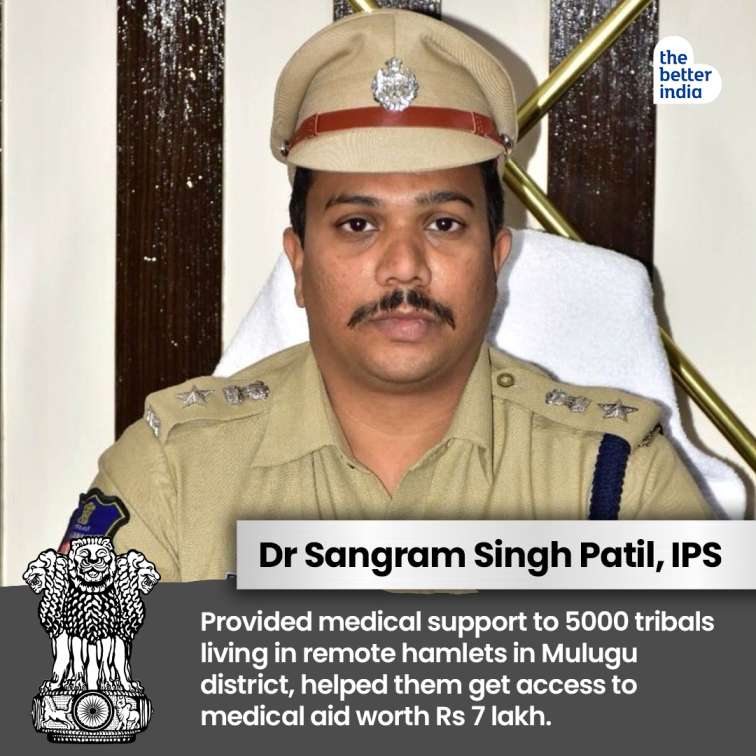
It was the initiative launched by Superintendent of Police Dr Sangram Sigh Patil that has helped over 5000 members of the Gotti Koya tribal community gain better access to healthcare. Dr Sangram left his medical career to join the civil service in 2015. Since 2019, Dr Sangram has helped over 5,000 tribals from 100-odd hamlets in the district, address various complaints including those of nutrition deficiency, haemoglobin, skin, and other related ailments. With the help of this officer, medical help worth Rs 7 lakh has reached the tribal community members.
Speaking to The Better India, he said, “As a part of routine patrolling, police officials are required to move around these remote parts of the district. The agency areas where these vulnerable communities live are non-accessible by vehicles and sometimes require walking for miles.” With the help of doctors from the Indian Medical Association, Warangal and health officers from the government district hospital and health centre over 20 doctors joined hands to systematically reach out to the community members.
This initiative has also helped in building a sense of trust between the police department and the tribal community members.
If you found our stories insightful, informative, or even just enjoyable, we invite you to consider making a voluntary payment to support the work we do at The Better India. Your contribution helps us continue producing quality content that educates, inspires, and drives positive change.
Choose one of the payment options below for your contribution-
By paying for the stories you value, you directly contribute to sustaining our efforts focused on making a difference in the world. Together, let’s ensure that impactful stories continue to be told and shared, enriching lives and communities alike.
Thank you for your support. Here are some frequently asked questions you might find helpful to know why you are contributing?


This story made me
- 97
- 121
- 89
- 167











